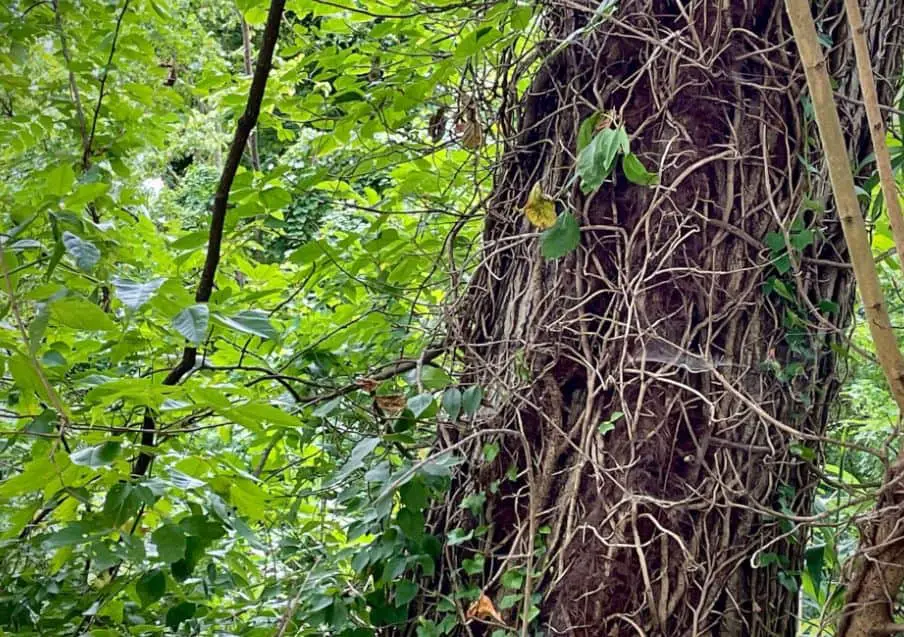Those lovely flowering vines in your backyard might be invasive vine weeds, which you might not know. When plants escape cultivation and invade uncultivated regions, the ecology is said to be impacted. The possibility of invasiveness in other plants should be considered. The vines listed below are potentially hiding in your garden.

Common Invasive Vine Species in Gardens and Yards
Identification of climbing invasive vines may be challenging, particularly when multiple vines seem the same. Pay attention to the kind of root structure, blooming, seed pods, berries, and opposing or alternating leaf arrangements.
The usual methods for removing invasive vines are mowing, pulling/digging, cutting and recutting, or chemical treatment. Try covering plants with cardboard and newspaper, followed by mulch. Moreover, removing flowers can stop the development of seeds. The vines may need to be entirely eliminated for many seasons. Here are seven of the most prevalent invasive or weedy vines:
1. Sweet Autumn Clematis
The shaded regions are brightened by the abundance of tiny, white blooms produced by the sweet autumn clematis (Clematis terniflora) in late summer or fall. Its alluring aroma entices unaware customers to buy this plant or accept a division from friends and neighbors. This seemingly innocent vine can invade your yard because of its many seeds and underground runners. This tenacious vine will proliferate, climbing over shrubs and perennials and even encroaching on the grass if the seed heads are not removed in the autumn.
Search for the native Clematis virginiana as a replacement. The leaves help you differentiate between them. The margins of the native species are sharp, whereas those of the invasive terniflora are smooth.
2. Chinese and Japanese Wisteria
Popular and fragrant Chinese wisteria (Wisteria sinensis) is a vine often linked to the southern allure. Before leafing out, it produces lilac or white flowers hanging in long branches from the thick vines, frequently supported by pergolas. Its once-romantic vegetation gradually becomes a gardener’s worst nightmare as the invasive vines crawl over everything in their path, shading adjacent plants and eventually killing them. Wisteria vines encroach high into tree canopies to block sunlight from reaching the leaves. It may suffocate native plants, gaining the label of invasiveness. Although it is not as common as Chinese wisteria, Japanese wisteria (W. floribunda) is just as invasive.
Alternative vines include the evergreen wisteria (Millettia reticulate), which is hardy in USDA zones 8 to 10, and the American wisteria (Wisteria frutescens), which is hardy in USDA zones 5 to 9.
3. Japanese Honeysuckle
Invading Japanese Honeysuckle (Lonicera japonica) was brought to America from Asia in 1806 as an attractive plant. The aggressively spreading vine soon beyond its boundaries and became illegal in several places. It may be identified by its ovate, green, opposite-on-the-stem leaves, fragrant white blooms that become yellow with maturity, and blue to black berries. Small trees and shrubs can be crushed by their enormous weight. If it is discovered growing in your yard, it is advised that it be eradicated.
A suitable alternative and hummingbirds’ preferred nectar plant is coral Honeysuckle (Lonicera sempervirens).
4. Kudzu
In 1876, Japan sent kudzu (Pueraria montana var. lobata) to the United States for decorative purposes. It was extensively planted before its invasive character was realized to stop soil erosion. The aggressive vine swiftly engulfs native species, denying them access to light, water, and nutrients while growing up to a foot (31 cm) daily. Its complex leaves are placed alternately with three heart- or oval-shaped leaflets. It is difficult to remove its tuberous roots without leaving behind pieces that regenerate. To get rid of it, most homes use chemical control.
Planting the hardy in zones 7 to 9 Carolina jessamine (Gelsemium sempervirens), which blooms in late winter to early spring with a profusion of yellow flowers, is an alternative.
5. English Ivy
The invasive plant known as English ivy (Hedera helix), denounced years ago, is widely used in the nursery industry. When planted as a groundcover, this Eurasian evergreen vine shades out other plants and attracts rodents. It is a climbing vine that poses a hazard to trees by enclosing the branches, and its weight may cause trees to fall over in bad weather. Birds consume and disseminate its seeds, and its waxy-coated leaves, often lobed with white veins, make it resistant to herbicides.
6. Honeyvine Milkweed
Ampelamus albidus, often known as honeyvine milkweed, seems to appear out of nowhere in yards, behind fences, or among shrubs. If left unchecked, the invasive vine with heart-shaped leaves and clusters of white blossoms will pick up pace and eventually take over. On a honeyvine, monarch butterflies sometimes lay eggs, although it is not their preferred location. Although the plant doesn’t produce milky sap as milkweeds do, it does yield a sizable pod.
7. Oriental Bittersweet
American bittersweet has been outperformed by Oriental Bittersweet (Celastrus orbiculatus), which has hybridized and almost supplanted it. Birds and people who cultivate them for decoration disseminate this plant’s orange berries. Trees may suffocate from their rabid growth and even collapse beneath their weight. In this instance, invasive vine identification by leaf requires distinguishing between juvenile, round leaves characteristic of the vine and older, pointed leaves. The orange-red roots of oriental bittersweet are another way to recognize it.
Invading vines in the yard may sneak up on you before becoming unmanageable. Pay attention to the enigmatic vines sprouting in your yard’s corners and remove them if required before they establish a grip.

